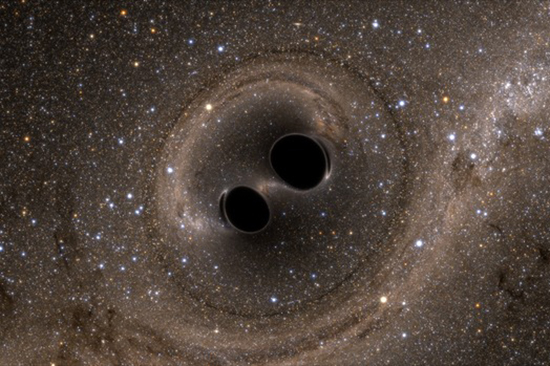Einstein Really Was a Genius: Gravitational Waves Detected
First direct spotting of space phenomenon predicted by relativity theory

One billion-plus years ago, two black holes merged, tossing off gravitational waves detected on Earth last September. Photo courtesy of the Simulating eXtreme Spacetimes (SXS) project
Normally, we try to tell you new things (that’s what “news” is about). But this event happened 1.3 billion years ago, when two black holes collided and formed one big monster hole. That crash sent ripples, called gravitational waves, through space-time that were detected directly for the first time last September and publicly announced last week.
It was September 14, 2015, at 5:51 a.m., to be exact, a date worth remembering given this monumental find, which confirmed yet another part of Albert Einstein’s theory of relativity. Einstein predicted the existence of such waves a century ago. Two high-tech detectors in Louisiana and Washington state, collectively known as the Laser Interferometer Gravitational-Wave Observatory (LIGO), operated by Caltech and MIT, picked up the waves.
Why did the discovery light up the world of astronomy like a supernova? BU Today discussed it with Alan Marscher, a College of Arts & Sciences professor and acting chair of astronomy.
BU Today: In lay terms, what are gravitational waves? Can they be produced in other ways besides the collision of black holes, as occurred in this case?
Marscher: Gravitational waves are gravity’s equivalent to light, which is an electromagnetic phenomenon. Light is created when there is a disturbance in an electric/magnetic field, which means when a charged particle like an electron changes its speed or direction of motion. Gravitational waves are generated by changes in the locations of masses. In order for the gravitational waves to occur and to be strong, the changes need to be asymmetric. That is, a spherical body, which is symmetric about its center, won’t produce the waves. The phenomenon in the universe that we think should produce the strongest gravitational waves is when two black holes orbit each other so closely that they end up merging into a single, more massive black hole. That is what the LIGO team thinks that they detected last September.
Why is finding these waves so important? What will it allow astronomers to learn that they might not have learned otherwise?
The merging of black holes is a phenomenon that cannot generally be observed with light, since black holes don’t allow light to escape, although in some black-hole systems we can see light from matter falling toward the black hole. In the case of the LIGO detection, the signal matches that expected from two black holes with masses near 30 times the mass of our sun, orbiting very close to each other, and then merging. The energy released in gravitational waves from such an event corresponds to what one expects if the event occurred in a galaxy about 1.3 billion light-years from us. So, with LIGO we see the emergence of a new sort of telescope that uses gravitational waves instead of light to explore extreme events in the cosmos.
Now that we’ve confirmed the waves, what’s the next step in this field of astronomical research?
Although this is the first direct detection of gravitational waves, they were confirmed indirectly in the 1980s when Joseph Taylor and Russell Hulse [winners of the 1993 Nobel Prize in Physics] observed the “decaying” orbits of two pulsars (spinning neutron stars) that lose energy to the emission of gravitational waves. The next step is to continue to refine LIGO’s sensitivity and to send a more sensitive NASA detector, LISA (Laser Interferometer Space Antenna), into space. This should allow observations of less extreme and more distance events than the one reported last week, and probably to observe these events frequently enough to study them systematically.
Will the discovery guide any research being done by BU, such as our work with the Discovery Channel Telescope?
Not at this stage. My own research group observes radiation from high-speed jets of particles seen at the centers of galaxies that contain black holes with masses about a billion times our sun’s mass. While there are some theories that many of these black holes are really pairs of black holes, the gravitational wave detectors won’t be sensitive enough to detect these systems in the near future.
The name Einstein has long been synonymous with genius. What effect will this confirmation of one of his theories have on this appraisal of him?
Well, Einstein will always be considered a genius, since his theories were so far advanced from what others had done—and were even thinking about—in the early 20th century. Beyond that, though, it’s amazing that none of his main theories have been found to be even slightly inaccurate. Relativity—both the part dealing with gravity and the part about phenomena occurring near the speed of light—has passed every test so far.

Comments & Discussion
Boston University moderates comments to facilitate an informed, substantive, civil conversation. Abusive, profane, self-promotional, misleading, incoherent or off-topic comments will be rejected. Moderators are staffed during regular business hours (EST) and can only accept comments written in English. Statistics or facts must include a citation or a link to the citation.